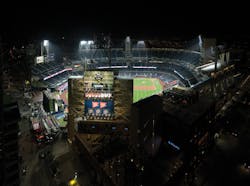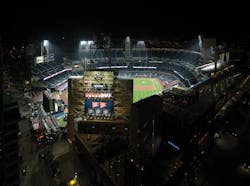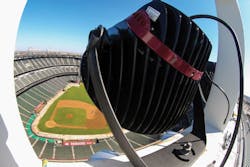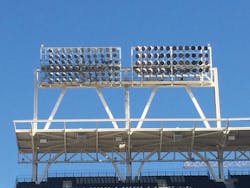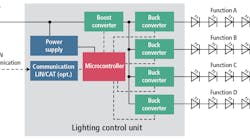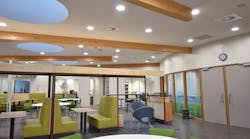SSL products are delivering energy savings and better light for baseball players and fans, reports MAURY WRIGHT, and network controls enable special effects that enhance the experience of America's Pastime.
Five of the 30 ballparks that host Major League Baseball (MLB) teams now use LED lighting to illuminate the playing field. Solid-state lighting (SSL) brings typical savings of around 40% in energy consumption, and significantly reduces the maintenance costs associated with re-lamping legacy high-intensity discharge (HID) fixtures. Still, the light quality is perhaps more important to players and fans, and the instant on-off ability of LED-based lights combined with network controls allows the teams to present dynamic light shows before or after games and for special events such as concerts.
Interested in articles & announcements on LED lighting for sports venues & entertainment?
Prior to the 2016 baseball season, only the Seattle Mariners had installed LED lights, having done so prior to the 2015 season. That lighting was supplied by GigaTera in partnership with PlanLED (http://bit.ly/1CMAHW6). The New York Yankees installed GigaTera fixtures last December just before Yankee Stadium hosted the Pinstripe Bowl college football game.
Just prior to the start of the 2016 baseball season, the San Diego Padres, Texas Rangers, and Houston Astros all installed LED lighting. Musco Lighting supplied the SSL luminaires to the Padres (Fig. 1 and cover) and Astros. Eaton's Ephesus Lighting supplied the SSL luminaires to the Rangers.
Dynamic lighting
The Padres home season opened with a series against the Los Angeles Dodgers and each night featured a spectacular pregame light show with individual luminaires controlled and choreographed to music and with a dramatic firework-like experience. The other venues mentioned have similar capabilities. Indeed, the Rangers have a video that demonstrates the dazzle of the LED lighting.
FIG. 1. The San Diego Padres opened their home season with games against the Los Angeles Dodgers under new LED lighting for the playing surface. Source: Musco Lighting.
Both the Padres and the Rangers have implemented fiber-optic network links to the light racks. The SSL systems then use DMX technology to individually control luminaires. The sports-field lighting can further be synchronized with the so-called ribbon boards that are commonly mounted on façades around the interior of the ballparks.
The aforementioned instant-on-and-off capability affords the ballpark operators many new tools to entertain fans and create drama, although MLB is reigning in the creative use of the lighting during games. The legacy HID lighting in most stadiums, ballparks, and arenas requires lengthy restrike periods if the lights are powered off. Most often, control is implemented via mechanical shades and louvers.
The Padres, for instance, programmed the precisely aimed LED lighting to selectively illuminate and create a spotlight-like effect to highlight a relief pitcher, or so-called closer late in the game, coming from the bullpen to the pitcher's mound. But thus far MLB has dictated that the lights must remain on at normal light levels during games, presumably in case other players were warming up on other parts of the playing surface. Surely as MLB gains more experience with LED lighting, things will change, and events such as concerts will make great use of the lighting and controls. San Diego will host the MLB All-Star Game, commonly called the Midsummer Classic, in July. You may know how or if MLB utilized the LED lights by the time you read this article, but as we went to press the plan was undecided. We would expect to see an impressive demonstration.
Energy efficiency
Still, energy efficiency plays a huge role in sports-venue operators investing in LED lighting. Utilities generally use a tiered rate structure, and customers that consume more energy pay more dollars per kilowatt hour. Padres director of communications Shana Wilson said Petco Park goes up a tier in rate structure essentially as soon as the field lighting is powered on. Moreover, San Diego has very high electrical rates and the LED lighting has cut energy usage by nearly half.
According to Randy McWilliams, senior director of facility services and engineering for the Padres, the team evaluated lights from several sources including Musco, Ephesus, and GigaTera. Ultimately, 476 of the SportsCluster Green luminaires were installed. McWilliams said slightly fewer of the Ephesus products would have lit the field to MLB standards, but the Musco products were judged to deliver more lumens to the playing surface and produce less glare. Glare and light spill were especially of concern given the close proximity of tall buildings with glass surfaces that could reflect light and impact the vision of players and fans.
MLB requires horizontal illuminance of 250 fc on the infield and 200 fc on the outfield at a major league park. The Padres' lighting has been measured using a precise grid and the infield light levels max out at 390 fc while the outfield levels hit 350 fc. McWilliams said the team would likely operate the lights at 80% to 90% of maximum, essentially extending the life of the luminaires. And the levels can be raised in the future as inherent lumen depreciation occurs.
Luminaire selection
In reality, both the manufacturers and the teams are finding their way slowly in a very new world of lighting for the playing surface. Then again, there are only the 30 aforementioned opportunities to light an MLB park, although there are hundreds of minor league facilities and college venues that will eventually all be converted to SSL. Ephesus, for example, recently lit the baseball venue at Vanderbilt University (Fig. 2). Still, the MLB stage will remain the most demanding.
FIG. 2. Hawkins Field at Vanderbilt University received an upgrade to Ephesus LED lighting prior to the 2016 Commodores baseball season. Source: John Russell/Vanderbilt Athletics.
The Musco, Ephesus, and GigaTera products are all quite different. GigaTera uses a rectangular design with no secondary reflectors. Moreover, GigaTera appears to use more closely-packed LED arrays. The Ephesus and Musco products look like more traditional HID sports lighting with a round shape and reflector that's evident. And both utilize total-internal reflection (TIR) optics on the individual LED sources much like most LED street lights utilize to form a beam.
Ephesus integrates the entire SSL system, including the driver and controls, into the Stadium Pro luminaires such as the one used in the Rangers' park (Fig. 3). Mike Lorenz, president of Eaton's Ephesus Lighting, said that while integration is a challenge, it provides advantages in a project. He said external drivers can introduce EMI (electromagnetic interference) into an environment. Lorenz explained that the company's engineers managed to separate the driver and light engine with thermal mitigation on each subsystem and still deliver the complete luminaire at 50 lb. Moreover, he said there are multiple microcontrollers (MCUs) in each luminaire for both the control and communications, and to precisely control the operation of each LED. Lorenz noted that the system design under-drives the LEDs to maximize performance and lifetime.
FIG. 3. Ephesus Stadium Pro luminaires integrate driver electronics and network controls in the enclosure with the LED light engine. Source: Kelly Gavin/Texas Rangers.
Musco implements controls at the driver level. In the Padres installation, one driver handles a pair of luminaires, although each luminaire can still be individually controlled. The installation crews mounted the drivers on the back of the racks to which the luminaires were affixed.
Ballpark installation
The installation processes differ based on stadium and luminaire type as well. The Mariner and Yankee projects that feature GigaTera products have many of the lights mounted along roof lines whereas the Padres and Rangers projects include large racks above the roof line with many fixtures in a rack. The Astros' park is a hybrid of the two. The point is that things like mounting height and the need to have lights concentrated in racks or uniformly distributed will impact the selection process.
The one similarity in all of the MLB projects is the level of commitment that the lighting manufacturers must make to bring the projects to success. The MLB teams, local utilities, and other consultants may participate in the process. But in such a specialty application, application teams from the lighting manufacturers must create a complex photometric plan up front, and implement according to that plan with precise detail.
The installation process, however, is varied. In the case of the Rangers' Globe Life Park, each individual luminaire was hoisted into position with a pulley. The video linked earlier shows an example of the installation process, and how a green laser attached temporarily to the hood of each luminaire, directed to a precise location on the field, enables the work crew to precisely align the luminaire.
FIG. 4. Musco worked with the San Diego Padres, assembling new LED lighting racks on the ground and then hoisting finished racks to the top of Petco Park. Source: San Diego Padres.
Musco and the Padres took a different approach. The Padres removed entire racks of existing lights using a crane. The team assembled new racks with the LED luminaires on the ground with alignment dictated by the photometric plan. Then the entire new racks were hoisted into place with a crane with only fine-tuning left to ensure precision (Fig. 4).
Field lighting characteristics
According to Ephesus' Lorenz, the precision of the LED lighting "equates to a rifle where traditional sports lighting was more of a shotgun." The Rangers' infield is lit to 250-300 fc and the outfield to 200-250 fc. Lorenz bragged that "in the eyes of some it's better than natural light."
The quality certainly matters to players and fans present in the stands but to TV viewers as well. The TV crew working the Rangers' park said they are able to close the iris of their cameras by three f-stops relative to the old lighting. That fact enables far better depth of field. Lorenz added that vertical illuminance is also very important with the cameras located in first- and third-base dugouts working from such low angles.
There is also the question of color temperature. The Padres' McWilliams said the organization chose 5700K-CCT lights to be near the experience of sunlight. Ephesus actually offers white-point tuning in its Stadium Pro family. The Rangers have the ability to vary the CCT over about a 1500K range from about 4000K to 5500K. When you see the luminaires up close, you can see the mix of different LED types under the TIR lenses.
Lorenz said determining the best CCT for baseball will be a learning process based on fan and player experience. No one knows at this point if there will be a clear reason to adjust CCT based on time of night or perhaps weather conditions. But the white tuning has come into play in other sports applications. The same feature is in the LED-based lighting installed last year at the Bridgestone Arena, home of the Nashville Predators National Hockey League team. Lorenz said the hockey players see better with the lighting at 5500K given the white playing surface. But most arenas are multipurpose venues and the Southeastern Conference basketball tournament held at Bridgestone used the lights near 4000K.
SSL enables opportunities
The move to LED lighting does provide other tangible but unexpected benefits to pro sports teams beyond energy and maintenance savings and great light quality. In the case of the Padres, McWilliams said fewer LED fixtures were required to light the field relative to the prior HID fixtures. That reduction can be seen in Fig. 5 where the rack on the left is the old lighting with six rows of fixtures and the rack on the right is the LED lighting with four rows.
Of course, fewer fixtures impacted the energy and maintenance story. But it left McWilliams with space below the bottom row of sports lighting to install a row of lights focused down into the seating bowl. That lighting may be used for cleaning crews, although the granular control and low-energy use of the field lights might make the sports lighting usable for cleaning purposes as well. McWilliams also installed RGB fixtures in that lower row, and the operators of Petco Park will now have the option of bathing the seating bowl in colors.
FIG. 5. The prior lighting in the rack on the left at Petco Park has more fixtures installed in six rows than the SSL on the right with only four rows. Source: San Diego Padres.
The new lighting even affects security. McWilliams said the Padres have typically left one rack of lights on each night so guards would see if someone were to scale a fence into the venue and try to enter the playing surface. McWilliams said the team can now rotate leaving select LED luminaires powered at night, typically at dim levels below maximum for security purposes.
While we have discussed quality as being more important than energy and maintenance savings, those savings are clearly still important. Ephesus said Globe Life Park will realize 60% energy savings. McWilliams said the Padres will realize $100,000 per year in electrical savings, and the team had previously spent upwards of $40,000 per year on relamping. Sports venue lighting is clearly ripe for SSL technology now that LED sources can produce the requisite light levels and system design has progressed to the point that fixtures are comparable in weight and size to legacy lighting.
